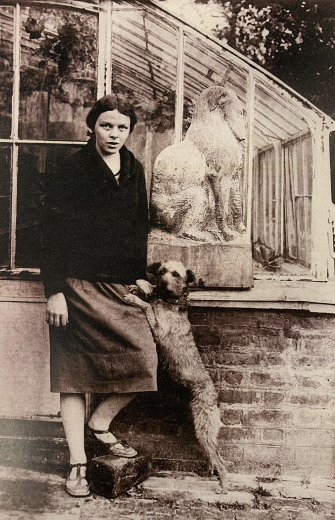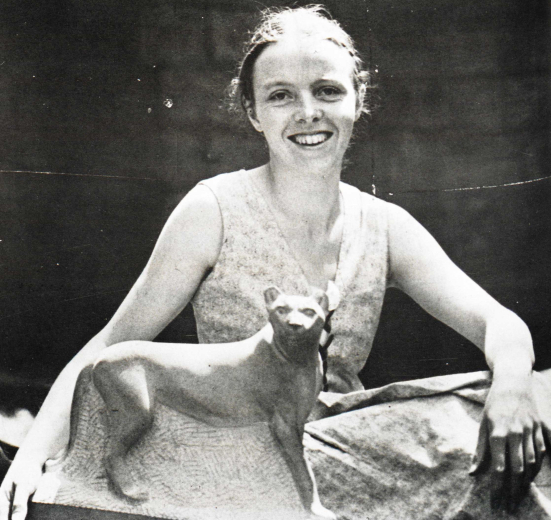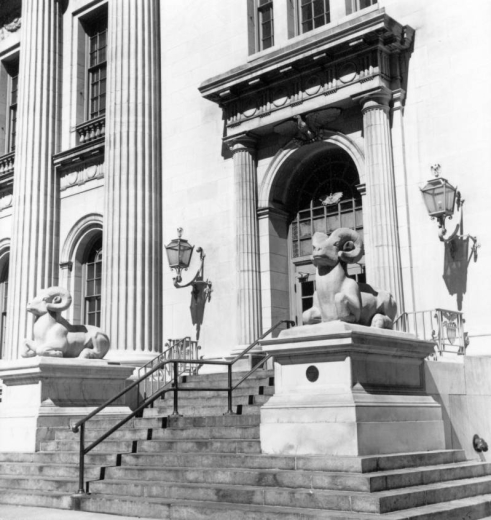Artist, particularly known for her sculptures of animals.
Gladys Caldwell Fisher was born in Loveland, CO, in 1907. Her family moved to Denver when she was 12 years old. When she was still a girl, her father would bring her clay from the foothills, which she used to model all sorts of animals that she saw in Colorado. She always had a fascination with wildlife. When she started attending Morey Middle School, she was able to take her first serious art classes. After moving on to East High School, she met Miss Helen Perry. Miss Perry saw the talent in Gladys and helped get her into Denver's Beax Arts Atelier school where she began learning to be a serious sculptor.
At 19 years old Gladys won the coveted Denver Allied Arts Scholarship. Because of this, she was able to move to New York and study at the American School of Architecture. Her teacher there was a famous cubist sculptor from the Ukraine, Alexander Archipenko. Besides her school, New York was a great place to make friends with and learn about other great artists of the time. By 1927, she had received a second Allied Arts Scholarship which allowed her to travel to Paris to study for two more years at the Academie de la Grande Chaumiere. Among her teachers was the great artist Aristide Maillol. He helped her create a sculpture of Gertrude Stein. Stein was a famous American poet who spent a great many years in Paris. Gladys learned from many talented artists while she was overseas.
By the time she returned to the U.S. in 1929, the Great Depression had begun. This made it both harder and more important that she find work. In New York she was able to get a job teaching while also selling her art. By 1932, she was offered a position teaching at the University of Denver and returned to Colorado. She also reconnected with a wealthy couple she had met when she was younger. Jean and George Cranmer served as her patrons and provided her with a place to live and a small studio at Chappell House. Chappell House became a popular community of artists during the Depression in Denver.
During this time, she got to know an architect named Alan Fisher. They would be married in 1936. She also met Anne Evans, president of the Denver Arts Commission. She found Gladys work with the Coors Ceramics Company producing molds and designing small ceramic buffalos to celebrate the new Boulder college football team. She was to be paid 15 cents for each buffalo sold. Around this time, the Roosevelt Administration began the Public Works of Art Project. the PWAP was a way to put artists to work during the Great Depression and provide art that everyday Americans could have access to.
Under the PWAP, she was hired to carve a bas-relief into a 10 foot by 6 foot stone slab for the new City and County building in Denver. The carving was to show "Indian Orphans and wild animals" and was named "American Indian Orpheus and the animals." This carving was later moved to city hall where it can still be seen today. In 1935, she was also hired by the designer of Hoover Dam to make a scale model of the dam for the government.
Later that same year, she began work on two 10-ton big horn sheep that are currently in front of the federal judiciary building in Denver. Part of her preparation involved going to observe live animals in their natural habitat in Yellowstone National Park. After this, she continued to receive more government commissions for work. This included a pair of grizzly bear cubs that would be displayed in front of the Mammoth Hot Springs Post Office in 1941. During this period, she also carved a wooden red fox for the shrine of the famous English author and poet, D. H. Lawrence, at his home in Taos, New Mexico.
By the 1940s, Gladys and her husband had two children, and she was not working as much as she had been in the past. She did, however, display a life-sized Malayan Collar Bear in 1947 to great acclaim. Sadly, she died young in 1952, and her son died in 1960 at age 16. Because she and her children had so loved animals, her husband, Alan, eventually donated the Malayan Collar Bear to the Sisters of Charity in Pueblo. These nuns ran a hospital and worked to help children and others in the community. When the convent closed in 1972, Alan Fisher then donated the bear to Denver Public Library. To this day, children are still free to admire and pet the bear on the 5th Floor of the Central Library.
foothills - a hilly area between the mountains and the plains
coveted - to be eagerly wished for
cubist - a style of art that looks less natural because forms are given sharper angles or more exaggerated shapes, showing more sides of an object at once
Great Depression - a period of widespread poverty and unemployment that started in 1929
patrons - people who support an artist through money, gifts, or effort
bas-relief - a three-dimensional image carved into stone
habitat - the natural environment of a living organism
commissions - money paid for a service
acclaim - to applaud someone with great approval
Do you think being a woman in the 1930's posed a particular challenge to an artist like Gladys? Why or why not?
Do you think having teachers both in the United States and Europe benefited her art? If so, how?
What impact do you think living through the Great Depression had on her art and her life?
Have you ever created art? How did it make you feel?
Gladys Caldwell Fisher papers, 1917-1942 (a collection of letters and newspaper clippings about Fisher and her family)
Colorado women artists of the New Deal (a book about Fisher and other women artists who worked for New Deal projects like the Federal Art Project)
Southwestern art vol.1 no.4 (a magazine article about the red fox Fisher carved for the tomb of author D. H. Lawrence)
An encyclopedia of women artists of the American West (Gladys Fisher is listed in this book along with many other Western women artists)
The Denver artists guild : its founding members : an illustrated history (this is about the local group of artists to which Gladys belonged)





